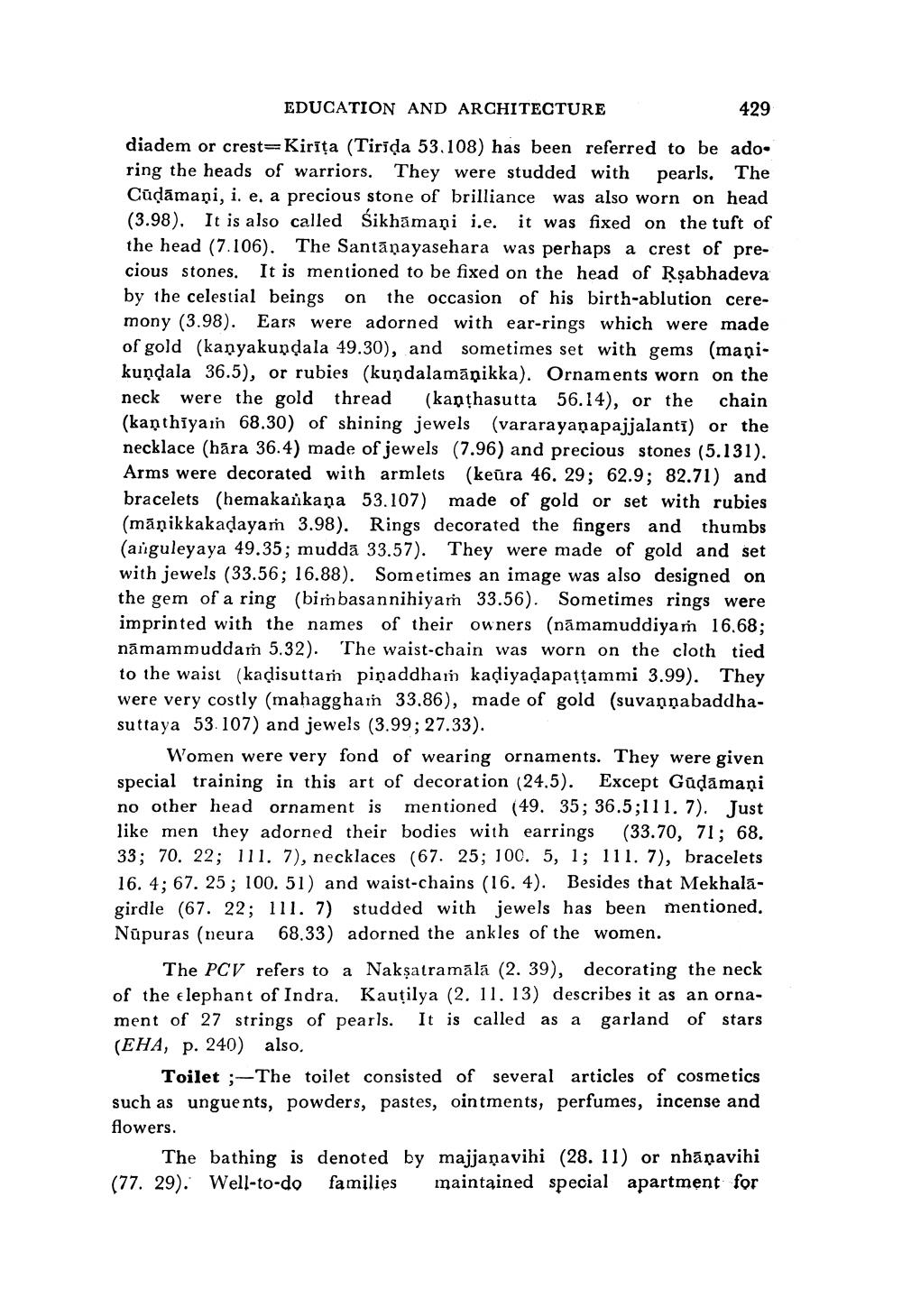________________
EDUCATION AND ARCHITECTURE
429
diadem or crest=Kirīța (Tirida 53.108) has been referred to be adoring the heads of warriors. They were studded with pearls. The Cūdāmani, i. e, a precious stone of brilliance was also worn on head (3.98). It is also called Sikhāmaņi i.e. it was fixed on the tuft of the head (7.106). The Santāņayasehara was perhaps a crest of precious stones. It is mentioned to be fixed on the head of Rşabhadeva by the celestial beings on the occasion of his birth-ablution ceremony (3.98). Ears were adorned with ear-rings which were made of gold (kanyakundala 49.30), and sometimes set with gems (manikundala 36.5), or rubies (kundalamāņikka). Ornaments worn on the neck were the gold thread (kanthasutta 56.14), or the chain (kanthiyaı 68.30) of shining jewels (vararayanapajjalanti) or the necklace (hāra 36.4) made of jewels (7.96) and precious stones (5.131). Arms were decorated with armlets (keūra 46. 29; 62.9; 82.71) and bracelets (hemakankaņa 53.107) made of gold or set with rubies (māņikkakadayam 3.98). Rings decorated the fingers and thumbs (arguleyaya 49.35; muddā 33.57). They were made of gold and set with jewels (33.56; 16.88). Sometimes an image was also designed on the gem of a ring (bimbasannihiyam 33.56). Sometimes rings were imprinted with the names of their owners (nāmamuddiyaṁ 16.68; nāmammuddam 5.32). The waist-chain was worn on the cloth tied to the waist (kadisuttar piņaddhain kadiyadapaštammi 3.99). They were very costly (mahagghain 33.86), made of gold (suvannabaddhasuttaya 53.107) and jewels (3.99; 27.33).
Women were very fond of wearing ornaments. They were given special training in this art of decoration (24.5). Except Gadamani no other head ornament is mentioned (49. 35; 36.5;111. 7). Just like men they adorned their bodies with earrings (33.70, 71; 68. 33; 70. 22; 111. 7), necklaces (67. 25; 100. 5, 1; 111. 7), bracelets 16. 4; 67. 25; 100. 51) and waist-chains (16. 4). Besides that Mekhalagirdle (67. 22; 111. 7) studded with jewels has been mentioned. Nupuras (neura 68.33) adorned the ankles of the women.
The PCV refers to a Nakşatramālā (2. 39), decorating the neck of the elephant of Indra. Kautilya (2. 11. 13) describes it as an ornament of 27 strings of pearls. It is called as a garland of stars (EHA, p. 240) also.
Toilet ;-The toilet consisted of several articles of cosmetics such as unguents, powders, pastes, ointments, perfumes, incense and flowers.
The bathing is denoted by majjanavihi (28. 11) or nhānavihi (77. 29). Well-to-do families maintained special apartment for
.5;11, Idama
rings
"chain":100.




